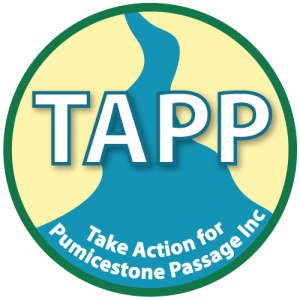Pumicestone Catchment Convergence
Traditional Owners (facilitator Liz Gould)
Note: no attendees identifying as Traditional Owners were present at any table
Underlying principles: “nothing about me without me” and “free, prior and informed consent”
What Do We Need to Know?
- Who to talk to? Where to get information? How to learn?
- How do we get appropriate inclusion?
- How can we increase engagement to benefit from TO knowledge in a non-exploitative way?
- Recognition that:
- building trust and relationship takes years
- differences between coastal and western areas of SEQ, likely a reflection of public/private land proportions (potentially greater loss of connection to country in western areas) and population density
- TO practices and significant locations (journeys, landscapes, etc)
- TO’s a potential source of knowledge on landscape change, e.g., middens, scar trees – useful for land management, but ownership and protection of knowledge critical
- Sharing stories – who has ‘authority’ to tell these? E.g., TO, non-TO, non-Indigenous?
- How to facilitate TO engagement? Creating a cultural economy?
- Understanding/addressing sensitivities associated with loss of cultural knowledge that has occurred as a result of past forced removal from country
What Do We Need to Do?
- Increase education of broader community awareness and acknowledgement of TOs, e.g., via Tourist Information Centres, local frameworks
- Request respectful involvement in all NRM activities, e.g., MoUs, financial support (build this into grants, projects, etc)
- Build understanding / management of cultural values into private nature conservation programs, e.g., Land for Wildlife
- Include cultural burn practicews in fire management
- Signage to alert of cultural values and promote awareness, but needs to be done carefully, e.g., not sensitive sites; potential for perverse outcomes; how best to protect culturally significant sites?
- Indigenous Land Corporation – does this still exist? An opportunity to purchase land and restore connection to country?
- Share positive stories on what works and appropriate framework for TO involvement
- Rate-based and visitor funding, e.g., crowdfunding to support improved TO outcomes in NRM
- Ensure cultural heritage assessments – by who? Not always done / properly (tick the box exercise); Cultural Heritage Act not working
- Need easily digestible and accessible information on Indigenous frameworks – as part of Citizenship process, but needs to be broader, e.g., schools, adult education
- Develop protocol based on consultation with TOs on how/when they would like to be engaged – and addressing time, funding and other resourcing needs
Area 1
- Dedicate vacant Crown Land to National Park
- Provide greater protection to wader/shorebird use
- Revegetate and rehabilitate coastline
- Close airport – create large inner city park, retain and rehabilitate environment
- Make plans to manage the ocean breakthrough
- Regulate water craft (erosion, impact, safety)
- Increase knowledge or and protect cultural heritage, e.g., stone tools
- Use local knowledge – TO and long-term residents
- Need to know: benthic mapping, seagrass
Area 2
- Continue shell midden mapping
- Annual removal of marine debris
- Shorebird protection – reduce disturbance
- Expand, monitor oyster reefs
- Pacific Harbour dredging – tailings will be deposited in Ningi Creek Catchment with a risk of water contamination
- Managrove protection required in vicinity of residential
- Ecosystem services potential research
- Climate refugee relocation strategy
- Lyngbya management on the beaches, monitoring
- Continue mangrove monitoring, maintain database
- Land acquisition to protect and expand remaining bushlands
Areas 3 & 4
- Improve fire management for natura values
- Remove pines and restore natural vegetation
- Boat wash is damaging the National Park beach from Gallager Point to Poverty Point – mainly caused by launch traffic
- Loss of cultural knowledge due to relocation of Bribie Island Traditional Owners – opportunities to rebuild?
- Remove private vehicles from Bribie Island beaches
- Rewild Bribie Island with Coastal Emu
- Protect the WW2 forts from degradation
- Enforce protection of beaches – control 4WDs
- Remove vehicles from the beach, use road behind with parking and access points to manage usages
- Future use of HQ Plantations following closure should be for nature conservation
- Flora protection
- Exclusion zone
- Beach protection
Area 5
- Wildlife crossings (under and over) needed for Bruce Hwy
- Rubbish dumping in HQ forests in Sunshine Coast Council area (may be linked to / influence by tip fees)
- Improve public transport, e.g., fast rail (but within existing infrastructure corridor)
- No further loss of flora and fauna
- Rewilding, e.g., Coastal Emu, Brush-tailed Rock-wallaby, Whiptail Wallaby, Honey Blue-Eye
- Expand land acquisition for environmental reserves
- Do not expand urban footprint in catchment
- Cultural Heritage Manager Plant for Wild Horses
- Fence Highway
Area 6a
- Research into stormwater treatment facilities’ long term maintenance
- Impact of urban development on stormwater / water quality and flow – aquifer renewal?
- Knowledge gap (and resource) – maintenance of effectiveness of urban water infrastructure post-developer
- Acquisition for nature conservation
- Do not expand urban footprint
- Significant cultural heritage needs protection in Glasshouse area, e.g., bora rings
Area 7b
- Coastal ecosystems have nowhere to go with climate change – modelling and mitigation (if possible) is needed
- Sea level rise impact on people and natural/culturatl values – where moving to?
- Add items from Areas 1 and 2
